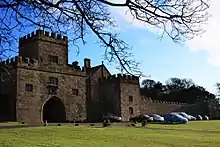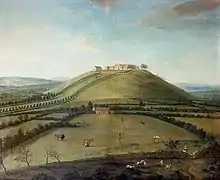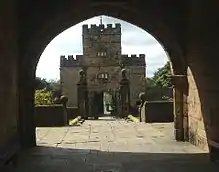Hoghton Tower
Hoghton Tower is a fortified manor house located about two-thirds of a mile (1 km) to the east of the village of Hoghton, Lancashire, England, and standing on a hilltop site on the highest point in the area. It takes its name from the de Hoghton family, its historical owners since at least the 12th century. The present house dates from about 1560–65.
| Hoghton Tower | |
|---|---|
 | |
| Location | Hoghton, Lancashire, England |
| Coordinates | 53.7329°N 2.5735°W |
| OS grid reference | SD 623,264 |
| Elevation | 560 ft (170 m) |
| Built | c, 1560–65 |
| Built for | Thomas de Hoghton |
| Restored | 1862–1902 |
| Restored by | Sir Henry de Hoghton Sir Charles de Hoghton |
| Architect | Paley and Austin, James Bertwistle, Robert Dudley Oliver |
Listed Building – Grade I | |
| Designated | 22 October 1952 |
| Reference no. | 1072532 |
It was damaged during the Civil War and subsequently became derelict, but was rebuilt and extended between 1862 and 1901. The house is listed at Grade I, as is the Great Barn in its grounds, which is dated 1692. Also in the grounds are two structures listed at Grade II. The house and garden are open to the public at advertised times, and are administered by a charitable trust, the Hoghton Tower Preservation Trust.
History

The property is situated on a hill which may be described as "the last, southwesterly tip of the Pendle range".[1] The land on which the house stands has been in the possession of the de Hoghton family from at least the 12th century. The present building dates from about 1560–65, and was built for the Right Worshipful Thomas de Hoghton (1518–1580),[2] replacing an earlier house on or near the same site. It has been suggested that the property has links to William Shakespeare through Alexander Hoghton who died in 1581.[3][4]
King James I stayed in the house from 15 to 18 August 1617, while returning from his visit to Scotland.[5] He was accompanied by his favourite George Villiers, 1st Duke of Buckingham and by the Earls of Pembroke, Richmond, Nottingham, and Bridgewater; Lords Zouche, Knollys, Mordaunt, Grey, Stanhope and Compton; the Bishop of Chester Thomas Morton, many baronets and knights, and various Lancashire notables.[6] On 13 August he had hunted at Myerscough Lodge near Garstang where, according to the diary of Nicolas Assheton of Downham, the king spoke about "liberty to pipeing and honest recreation", in response to a petition from local people.[7] He was at Preston on 15 August and rode to Hoghton where he was met by two actors representing the household gods, one the domestic spirit and the other the guardian of the chase. The next day, a Sunday, there was an attempt to disrupt the church service at Hoghton with distracting noises, for the same cause. James listened to representations from Lancashire gentry and asked Bishop Thomas Morton to draft a response, a forerunner of the Book of Sports.[8] On Sunday afternoon James visited the nearby alum mines at Pleasington.[9] On Monday evening there was a masque danced by the lords and gentlemen on the circle of the lawn at Hoghton. The menu for the feast on the 17 and 18 August, with the names of the cooks and kitchen workers, survives.[lower-alpha 1] On 18 August the king left for Lathom House.[11] Following a petition of the people of Lancashire he lifted the restrictions on Sunday recreations, that culminated in the publishing, initially just for Lancashire, and then nationally the following year, of the Book of Sports.[6]
In 1643 the house was damaged by Parliamentary forces during the Civil War. In February 1643, after the taking of Preston by Sir John Seaton, Hoghton Tower was besieged by Parliamentary troops under Captain Nicholas Starkie of Huntroyd. At the time the house held a garrison of only 30-40 musketeers, who capitulated on 14 February. But when the Roundheads entered the house, the powder magazine in the old pele tower, between the two courtyards, exploded with immense force, killing over 100 Parliamentary men. This central tower was never rebuilt.[12]
From 1662, for over a hundred years, Hoghton Tower housed nonconformist services in the Banqueting Hall, after Sir Gilbert's son Sir Richard (1616-1678) converted to Presbyterianism[13] and by 1664 it had become a centre, in the Blackburn District, for both Independents and Presbyterians.[14] John[13] and Charles Wesley are reputed to have preached at Hoghton.[15]
In 1692–1702 Sir Charles de Hoghton, who founded Preston Grammar School, carried out repairs and rebuilding. King William III was a frequent visitor to the house, being a personal friend of Sir Charles.[16]
In 1768 the family permanently moved to another property and it was rented to local farmers;[17] by the middle of the 19th century the house was derelict.[18] Sir Henry de Hoghton, the 9th Baronet, inherited the estate in 1862 and decided to restore the house. It is not known who carried out the earlier part of the restoration, but by 1876 the Lancaster architects Paley and Austin were involved, having carried out work on rooms including the banqueting hall. Sir Henry died in 1876, and restoration work was continued by his brother, Charles, the 10th Baronet, although the house was not ready for him to take up residence until 1880. By that time Paley and Austin had restored the gateway tower and the adjacent walls (1877), designed an entrance lodge (1878), carried out work on the offices in the east wing, built a new kitchen, a new underground service corridor, and made other alterations (1879–80). Further work on the stables and farm buildings was carried out by the Blackburn-based architect James Bertwistle. Sir Charles died in 1893, and from 1896 to 1901 the London architect Robert Dudley Oliver added nursery accommodation, a smoking room, a billiards room and a large drawing room (later used as the ballroom).[19]
In 1854 Charles Dickens visited the house and found it in a depressing state of disrepair. The mood of the place inspired his 1868 short story George Silverman's Explanation, in which the house features prominently.[20][21]
Architecture

Hoghton Tower is constructed in sandstone, with stone slate roofs. It has a double courtyard plan, the outer courtyard being entered on the west side through a large gatehouse.[18] The gatehouse is embattled and in two storeys, with a central tower rising by more than one additional storey. Above its archway is a 16th-century cartouche containing a carving of Samson and the Lion. On each side of the gateway, embattled walls lead to square corner pavilions, which are also embattled. Buildings of differing dates stand on the north and south sides of the outer courtyard. This is in two levels, the eastern part being higher than the western. Between the two levels is a wall, and steps leading up to a gateway with 18th-century wrought iron gates between gate piers. In the northeast corner of the courtyard is a 17th-century well house, which stands on the traditional site of the original tower that was destroyed in the Civil War.[22] The inner courtyard has a west gateway, a great hall and kitchen on the north side, state rooms on the east, and living rooms on the south and west sides; it is mainly in two storeys. At the north east corner is a porch (this was formerly the site of a chapel). Bay windows project from the north and south sides of the great hall.[18]
Interior
The building has many interesting features including the Tudor Well House, which is 120 feet (37 m) deep and has a horse-drawn pump and oaken winding gear. The State Bedroom contains the State Bed carved at Samlesbury in about 1560-65. The beautifully proportioned Ballroom has fine, decorative late Victorian doors and panelling by Gillows of Lancaster. The Banqueting Hall has windows with 4,000 panes of Flemish stained glass, original decorative ceiling and a Minstrels' gallery.[16] The house is known to contain three priest holes, including one cut into the side of the well.[23][24][25]
Gardens and grounds

The house is approached by a long straight drive leading eastwards from the A675 road. It passes through a pair of gate piers about 200 yards (183 m) west of the house.[22] Between these gates and the entrance to the outer courtyard is a grassed area known as the Tilting Ground, which is enclosed by a wall on the south side and the Great Barn to the north. On the east side of the house is a walled garden, known as the Wilderness, and on the south side are smaller walled gardens, the Rose Garden and the Rampart Garden.[17] The Great Barn is constructed in sandstone with a slate roof, and incorporates a carthouse. It is dated 1692, and has ball finials on its gables. To the northwest of the house are the coach house and stables, also in sandstone, and dating from the 17th or early 18th century. A small cupola was added to it in the 19th century. At the entry to the drive on the main road is Paley and Austin's lodge of 1878.[17]
Present day
Hoghton Tower and the Great Barn were designated as a Grade I listed buildings on 22 October 1952.[18][26] Listed at Grade II are the coach house and stables,[27] and the gate piers on the drive to the west of the house.[28] The gardens are listed at Grade II on the National Register of Historic Parks and Gardens.[29]
In 1978 the Hoghton Tower Preservation Trust was established as a charity for the preservation of the house, and to encourage education and research. It raises income by "charging an admission fee to visitors, running events, providing holiday accommodation and being rented out as a venue for weddings, filming, corporate entertainment and private functions".[30] The house and gardens are open to the general public at advertised times. An admission fee is payable, which includes a guided tour of the house. Inside the house is a collection of dolls' houses.[31] Interior photography is not permitted. Refreshments are available in the tea room, and the stables have been converted into a gift shop.[32] Residential accommodation is available in a converted former garrison.[33]
The house has been used as a film location on a number of occasions. For example, parts of the second series of Last Tango in Halifax (2012) were filmed here[34][35] and the 2005 drama Cassanova starring David Tennant was partly filmed at the house.[16]
Since 2015 the house and estate has been run by a team headed by Elena Faraoni, daughter of the current 14th Baronet, Bernard. [36]
See also
Notes
- A false etymology of sirloin steak is the incorrect claim that during this visit, on 17 August, King James knighted the "Sir Loin of Beef".[10] snopes.com
References
- Singleton 1950, p. 1.
- Singleton 1950, p. 26.
- "William Shakespeare's connections with Preston revealed". Blog Preston. Retrieved 6 January 2015.
- Bearman, Robert (1 March 2002). ""Was William Shakespeare William Shakeshafte?" Revisited". Shakespeare Quarterly. 53 (1): 83–94. doi:10.1353/shq.2002.0002. S2CID 161459111 – via Project MUSE.
- Farrer & Brownbill 1911, p. 36-47.
- Singleton 1950, p. 7.
- James Craigie & Alexander Law, Minor Prose Works of James VI (STS: Edinburgh, 1982), p. 219: John Nichols, The Progresses, Processions, and Magnificent Festivities of King James the First, vol. 2 (London, 1828), p. 397.
- James Craigie & Alexander Law, Minor Prose Works of James VI (STS: Edinburgh, 1982), pp. 219-20.
- Historic England. "Alum quarries and works 800m north of Sandsend Bridge, Lythe (1018139)". National Heritage List for England. Retrieved 31 January 2020.
- Bilsborough, Norman (1989), The Treasures of Lancashire, Manchester: North West Civic Trust, pp. 96–97, ISBN 0-901347-41-8
- John Nichols, The Progresses, Processions, and Magnificent Festivities of King James the First, vol. 2 (London, 1828), pp. 397-403.
- "Sir Gilbert Hoghton". www.hoghtons.co.uk. Retrieved 19 November 2018.
- Singleton 1950, p. 14.
- Whittaker, George Henry (1981). Nonconformity in north east Lancashire 1662-1962 (PDF) (Thesis). Durham University.
- "Sitting Tight Since the Norman Conquest". Retrieved 21 November 2018.
- "Local landmarks: Hoghton Tower". bbc.co.uk. 29 June 2009. Retrieved 18 November 2018.
- Historic England. "Hoghton Tower (1000947)". National Heritage List for England. Retrieved 14 November 2012.
- Historic England. "Hoghton Tower (1072532)". National Heritage List for England. Retrieved 14 November 2012.
- Brandwood, Geoff; Austin, Tim; Hughes, John; Price, James (2012), The Architecture of Sharpe, Paley and Austin, Swindon: English Heritage, pp. 127–129, ISBN 978-1-84802-049-8
- International, American. "Hoghton Tower - Medieval Fortified Manor House in England". www.castlesandmanorhouses.com. Retrieved 18 November 2018.
- "When Charles Dickens visited Preston". Lancashire Evening Post. Retrieved 18 November 2018.
- Hartwell, Clare; Pevsner, Nikolaus (2009) [1969], Lancashire: North, The Buildings of England, New Haven and London: Yale University Press, pp. 339–343, ISBN 978-0-300-12667-9
- "Nicholas Owen – builder of priest holes". elizabethashworth.com. 13 May 2015. Retrieved 18 November 2018.
- "Will Shakeshaft and the cache in the rafters". independent.co.uk. 22 December 1999. Retrieved 18 November 2018.
- "Castle in the air". the Guardian. 24 July 1999. Retrieved 18 November 2018.
- Historic England. "Great Barn c.100 metres west of Hoghton Tower (1164490)". National Heritage List for England. Retrieved 14 November 2012.
- Historic England. "Coachhouse and stable c.4 metres north of north-west tower of Hoghton Tower (1164475)". National Heritage List for England. Retrieved 14 November 2012.
- Historic England. "Gatepiers c.200 metres west of Hoghton Tower (1072533)". National Heritage List for England. Retrieved 14 November 2012.
- Historic England. "Hoghton Tower (1000947)". National Heritage List for England. Retrieved 14 November 2012.
- History of Hoghton Tower, Hoghton Tower Preservation Trust, archived from the original on 2 September 2012, retrieved 14 November 2012
- Day Visitors to Hoghton Tower, Hoghton Tower Preservation Trust, retrieved 14 November 2012
- Market Tearoom and Gift Shop at Hoghton Tower, Hoghton Tower Preservation Trust, archived from the original on 13 November 2012, retrieved 14 November 2012
- Accommodation at Hoghton Tower, Hoghton Tower Preservation Trust, retrieved 14 November 2012
- "Filming starts on Last Tango in Halifax 2". What's on TV. IPC Media. 4 July 2013. Retrieved 17 September 2013.
- "Last Tango at the Tower this Autumn". Lancashire Evening Post. Johnston Press. 17 August 2013. Retrieved 17 September 2013.
- "Hoghton Tower - Lancashire's Wolf Hall has ghosts and sirloin steaks in a colourful past". Lancashire Life. 13 January 2015. Retrieved 18 November 2018.
Sources
- Singleton, Frank (1950). Hoghton Tower. Preston: W S Heane Ltd.
- Farrer, William; Brownbill, J., eds. (1911). A History of the County of Lancaster: Volume 6. London: Victoria County History.
Further reading
- Miller, George C. (1948). Hoghton Tower: The History of the Manor, the Hereditary Lords and the Ancient Manor-house of Hoghton in Lancashire, with a Foreword by the Present Baronet. Guardian Press.
External links
| Wikimedia Commons has media related to Hoghton Tower. |

